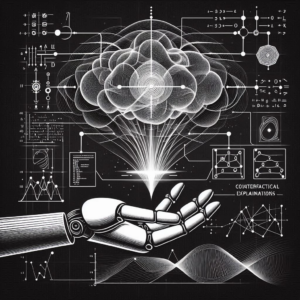Reinforcement Learning for Counterfactual Explanations

1. Introduction
Reinforcement learning (RL) is revolutionizing Explainable Artificial Intelligence (XAI) by offering new ways to generate counterfactual explanations (CFEs). These explanations help users understand how changes in input variables can lead to different predictions. In high-stakes fields such as finance and healthcare, CFEs enhance transparency and trust in machine learning models.
Despite their importance, generating effective CFEs is challenging, especially for complex models with high-dimensional data. To address this, we introduce SAC-FACT (Soft Actor-Critic for Counterfactual Explanations), a novel RL-based method. SAC-FACT leverages the Soft Actor-Critic (SAC) framework to generate optimal CFEs by balancing exploration and exploitation. Through a carefully designed reward function, SAC-FACT ensures validity, proximity, and sparsity in its counterfactual explanations.
2. Background on Counterfactual Explanations
Counterfactual explanations describe hypothetical changes in input data that would have led to a different model prediction. They identify key variables that influence outcomes, allowing users to grasp the model’s decision process. The process of generating CFEs is typically formulated as a constrained optimization problem, ensuring that changes are minimal yet effective.
Key Characteristics of CFEs
1. Diversity: Providing multiple alternative explanations.
2. Validity: Ensuring counterfactuals are realistic and actionable.
3. Proximity: Keeping changes minimal to maintain relevance.
4. Sparsity: Modifying as few features as possible.
5. User Constraints: Respecting predefined modification limits.
By incorporating these principles, reinforcement learning enables more effective and interpretable counterfactual generation.
3. Reinforcement Learning and the Soft Actor-Critic Framework
3.1 Reinforcement Learning for Decision-Making
Reinforcement learning is a machine learning approach where an agent interacts with an environment to maximize cumulative rewards. It is widely used for complex decision-making tasks, including automated control and adaptive learning.
3.2 Soft Actor-Critic (SAC) Overview
SAC is an advanced RL algorithm that balances exploration and exploitation by introducing entropy regularization. It consists of three main components:
1. Policy Network (Actor): Determines actions based on current state.
2. Q-Function (Critic): Estimates the expected return for state-action pairs.
3. Value Function: Guides policy updates by estimating state values.
By maintaining a trade-off between learning stability and exploration, SAC efficiently handles complex, high-dimensional problems such as counterfactual generation.
4. Methodology: SAC-FACT for Generating Counterfactual Explanations
The SAC-FACT framework follows a structured process involving state-action representation, reward function design, and reinforcement learning-based training.
4.1 State and Action Spaces
State Space (S): Represents the input data requiring an explanation.
Action Space (A): Defined as feature-value modification pairs (f,q)(f, q), where ff is the feature index and qq is the modification percentage.
This setup allows the agent to explore feature modifications while ensuring interpretability.
4.2 Reward Function Design
The reward function is designed to guide SAC-FACT toward optimal counterfactual generation. It optimizes validity, proximity, and sparsity through the following formulation:
R(st,a,st+1)=σ−hamming(st,st+1)−gower(st,st+1)+anomaly(st+1)+δR(st, a, st+1) = \sigma – \text{hamming}(st, st+1) – \text{gower}(st, st+1) + \text{anomaly}(st+1) + \delta
Where:
σ\sigma penalizes excessive changes.
Hamming Distance measures the number of altered features.
Gower Similarity quantifies input similarity.
Anomaly Detection prevents unrealistic counterfactuals.
δ\delta rewards goal achievement.
4.3 Training the SAC-FACT Model
SAC-FACT is trained through iterative trial-and-error interactions, where the agent refines its policy based on cumulative rewards. Training continues until reward stabilization, indicating convergence.
5. Experimental Evaluation
5.1 Experimental Settings
We evaluated SAC-FACT using four datasets: Diabetes, Breast Cancer, Climate, and BioDeg. These datasets provide diverse feature sets to assess the model’s performance across different domains.
Key experimental parameters:
Models: Gradient Boosting classifiers trained for high accuracy.
Comparison Baselines: Diverse Counterfactual Explanations (DiCE) and SingleCF.
Evaluation Metrics: Validity, diversity, proximity, and sparsity.
5.2 Results and Discussion
SAC-FACT outperformed baseline methods across all metrics. Key findings include:
Higher validity rates, ensuring counterfactual feasibility.
Lower proximity scores, indicating minimal but effective modifications.
Greater diversity, providing multiple actionable alternatives.
These results highlight the potential of reinforcement learning in enhancing explainability in machine learning.
6. Limitations and Future Work
Despite its success, SAC-FACT presents some limitations:
1. Architecture Sensitivity: Performance varies with hyperparameter tuning.
2. Convergence Variability: Training time depends on dataset complexity.
3. Scalability: The current implementation requires training a separate model for each data point, which may be computationally expensive.
Future work will focus on:
Developing a unified model applicable across multiple data points.
Optimizing convergence strategies to enhance efficiency.
Exploring alternative RL architectures for improved adaptability.
7. Conclusion
This study introduced SAC-FACT, a reinforcement learning-based approach for counterfactual explanations. By leveraging the Soft Actor-Critic framework, SAC-FACT generates interpretable, actionable explanations with minimal modifications. Experimental results confirm its effectiveness in producing high-quality CFEs compared to traditional methods.
As the demand for explainable AI grows, reinforcement learning techniques like SAC-FACT will play a crucial role in improving model interpretability. Future research should explore the impact of different interpretations on evaluation of explanations and XAI, ensuring robust and user-centric explanation methods.
Do you like to read more educational content? Read our blogs at Cloudastra Technologies or contact us for business enquiry at Cloudastra Contact Us.